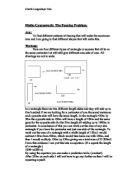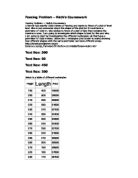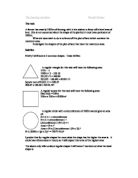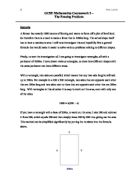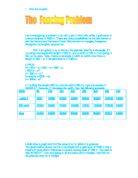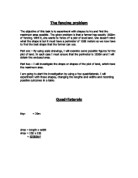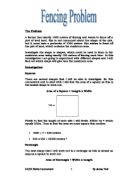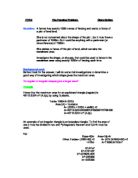The Fencing Problem
Maths Coursework: The Fencing Problem There is a need to make a fence that is 1000m long. The area inside the fence has to have the maximum area. I am investigating which shape would give this. Triangles: Scalene The diagram above is not to scale. Instead of having the perimeter to 1000m, only in this diagram, I have made the perimeters of the shape to 10, only to make this part of the investigation easier to understand. We know that the base of all the shapes is 2. The lengths for the equilateral triangle are 4 on each side. This part of the investigation is to explain why the triangle with the longest height cannot have the same base. The tallest triangle also has a perimeter of 10. One of the sides for the tallest triangle is 5, which is understandable. However the other side is 3. This is literally impossible to be because if this triangle was drawn to scale, then the side that is 3 will not end up reaching the base. The isosceles triangle has a side of 4 and it looks shorter than the side of 3. The only way the higher triangle will reach is if the base is shortened. So in the formula 'h x b ÷ 2', in the case of the higher triangle, the height will be longer but the base will be shorter. Looking at this diagram, there is no need to draw out tables to find out whether or not a scalene triangle is bigger than an equilateral or an isosceles in terms of area. I have made
The Fencing Problem.
Maths Coursework: The Fencing Problem. Aim; To find different patterns of fencing that will make the maximum area and I am going to find different shapes that will make this. Working; Here are four different types of rectangle or squares that all have the same perimeter but will still give different amounts of area. All drawings are not to scale. In a rectangle there are two different length sides and they will add up to five hundred if we are looking for a perimeter of one thousand metres so each opposite side will have the same length. In the rectangle 450m by 50m the opposite side to 450m will have a length of 450m and the same goes for the opposite side for the 50m length all-adding up to 1000m in perimeter. In conclusion of this you can work out the area of any size rectangle if you have the perimeter and just one side of the rectangle. To work out the area of a rectangle with a width length of 150m I would subtract 150m from 500m, which would then leave me with 350m, and then I would multiply 150m by 350m giving me a total area of 52 500m2. From this evidence I can put this into an equation. (If x equals the length of a rectangle.) 000=x(500-x) By using the equation you can make a prediction table. (overleaf). After 250m on each side I will not have to go any further as then I will be repeating myself. Length (m) Width (m) Area (m2) 0 500 0 0 490 4900
The Fencing Problem.
Fencing Problem - Math's Coursework Fencing Problem - Math's Coursework A farmer has exactly 1000 meters of fencing and wants to fence of a plot of level land. She is not concerned about the shape of the plot but it must have a perimeter of 1000 m. She wishes to fence of a plot of land that contains the maximum area. I am going to investigate which shape is best for this and why. I am going to start by investigating the different rectangles; all that have a perimeter of 1000 meters. Below are 2 rectangles (not drawn to scale) showing how different shapes with the same perimeter can have different areas. http://[email protected]/dsp_frameset.cfm?&cfid=2124468&cftoken=63911407 Text Box: 300 Text Box: 50 Text Box: 450 Text Box: 200 Below is a table of different rectangles. Height Length Area 00 400 40000 200 300 60000 210 290 60900 220 280 61600 230 270 62100 240 260 62400 250 250 62500 260 240 62400 270 230 62100 280 220 61600 290 210 60900 300 200 60000 310 90 58900 320 80 57600 330 70 56100 340 60 54400 350 50 52500 360 40 50400 370 30 48100 380 20 45600 390 10 42900 400 00 40000 410 90 36900 420 80 33600 430 70 30100 440 60 26400 450 50 22500 460 40 8400 470 30 4100 480 20 9600 490 0 4900 Using this table I can draw a graph of height against area. This
The fencing problem.
The fencing problem Daniel Briney The task A farmer has exactly 1000m of fencing; with it she wishes to fence off a level area of land. She is not concerned about the shape of the plot but it must have perimeter of 1000m. What she does wish to do is to fence off the plot of land which contains the maximun area. Investigate the shape/s of the plot of land that have the maximum area. Solution Firstly I will look at 3 common shapes. These will be: A regular triangle for this task will have the following area: /2 b x h 000m / 3 - 333.33 333.33 / 2 = 166.66 333.33² - 166.66² = 83331.11 Square root of 83331.11 = 288.67 288.67 x 166.66 = 48112.52² A regular square for this task will have the following area: Each side = 250m 250m x 250m = 62500m² A regular circle with a circumference of 1000m would give an area of: Pi x 2 x r = circumference Pi x 2 = circumference / r Circumference / (Pi x 2) = r Area = Pi x r² Area = Pi x (Circumference / (Pi x 2)) ² Pi x (1000m / (pi x 2)) ² = 79577.45m² I predict that for regular shapes the more sides the shape has the higher the area is. A circle has infinite sides in theory so I will expect this to be of the highest area. The above only tells us about regular shapes I still haven't worked out what the ideal shape is. Width (m) Length (m)
The Fencing Problem
GCSE Mathematics Coursework 2 - The Fencing Problem Scenario A farmer has exactly 1000 meters of fencing and wants to fence off a plot of level land. So therefore there is a need to make a fence that is 1000m long. The actual shape itself has to have a maximum area. I will now investigate this and hopefully find a general formula that would make it easier to solve various problems relating to different shapes. Firstly, to start the investigation of, I am going to investigate rectangles, all with a perimeter of 1000m. I have drawn various rectangles, to show how different shapes with the same perimeter can have different areas. With a rectangle, two sides are parallel, which means that any two-side lengths will add up to 500m. For example in a 200 x 300 rectangle, two sides that are opposite each other that are 200m long and two sides next to them that are opposite each other that are 300m long. With rectangles in this situation it is easy to work out the area, even with only one of the sides. 000 = x(500 - x) If you have a rectangle with a base of 200m, to work out the area, I take 200 and subtract it from 500, which equals 300 and then simply times 200 by 300 thus giving me the area. This method can be simplified significantly by putting the numbers into the formula above. Using the table of results above, I have produced a table of results : Height (m) x
The Fencing Problem
I am investigating a problem to do with a plot of land with either a perimeter or a circumference of 1000 m. There are many possibilities for the she farmer to plot her fence round the area of land. She can plot in triangles, hexagons, decagons, rectangles, squares etc. First, I am going to try to find out the greatest area for a rectangle. If I try using a rectangle with length of 400 m, and a width of 100 m, I am going to find out its area. Here, I have a rectangle of width w, which must have a length of 500 - w, if the perimeter is to 1000 m. CHECK: W + 500 - w + 500 - w + 500 - w. = 500 w - w2 A = 500 w - w 2 Its area is w (500 - w) A = 500w - w2 If I multiply the length (400 m) and the width (100 m), I get the answer of 40,000 m2. However, if I increase the width, I get the following answers: Width 50 00 50 200 250 300 350 400 - width 2 2500 0000 22500 40000 62500 90000 22500 6000 500 width 25000 50000 75000 00000 2500 50000 75000 20000 Area 22500 40000 52500 60000 62500 60000 52500 40000 I shall draw a graph and find the value of w for which A is greatest. The graph below shows me that a rectangle with a perimeter of 1000 m has a maximum area when it becomes a square, having sides of 250 m. The area is then 62 500 m2. I am now going to do the same with a triangle. I will find out the greatest area for a triangle. Area of
The fencing problem
The fencing problem The objective of this task is to experiment with shapes to try and find the maximum area possible. The given problem is that a farmer has exactly 1000m of fencing. With it, she wants to fence off a plot of level land. She doesn't mind what the shape is but it must have a perimeter of 1000 meters so we now have to find the best shape that the farmer can use. Part one - By using scale drawings, I will examine some possible figures for the plot of land. In each case I must ensure that the perimeter is 1000m and I will obtain the enclosed area. Part two - I will investigate the shape or shapes of the plot of land, which have the maximum area. I am going to start the investigation by using a few quadrilaterals. I will experiment with these shapes, changing the lengths and widths and recording possible outcomes in a table. Quadrilaterals Key: = 20m Area = length x width Area = 250 x 250 = 62500m² Area = length x width Area = 200 x 300 = 60,000m² Area = length x width Area = 350 x 150 = 52,500m² Area = length x width Area = 400 x 100 = 40,000m² Area = length x width Area = 450 x 50 = 22,500m² I have experimented with quadrilaterals and have decided to create a table with lengths varying from 0 to 500, going up in 10's. I have created this in a table below using the formula: Length x Width = Area Length (m) Width (m) Area (m2)
The Fencing Problem.
The Problem A farmer has exactly 1000 meters of fencing and wants to fence off a plot of level land. She is not concerned about the shape of the plot, but it must have a perimeter of 1000 meters. She wishes to fence off the plot of land, which contains the maximum area. Investigate the shape or shapes, which could be used to fence in the maximum area using exactly 100 meters of fencing each time. In this investigation I am going to experiment with different shapes and I will find out which shape will give here the maximum area Investigation Squares There are several shapes that I will be able to investigate for this coursework and to start with I will find the area of a square as this is the easiest shape to work out. Area of a Square = Length x Width Firstly to find the length of each side I will divide 1000m by 4 which equals 250m. Then to find the area we must square this number. * 1000 / 4 = 250 meters * 250 x 250 = 62500 meters ² Rectangle The next shape that I will work out is a rectangle as this is almost as easy as a square to work out. Area of Rectangle = Width x Length In this table in the following page I will work out the area for a large number of rectangles. I will put it in a table as this will be the easiest way to work out many different areas. Each time I will increase the length by 10 and decrease the width by 10 to see what different area I
The Fencing Problem
7/7/02 The Fencing Problem Clare Dutton Question: A farmer has exactly 1000 metres of fencing and wants to fence of a plot of level land. She is not concerned about the shape of the plot, but it must have a perimeter of 1000m. So it could be anything with a perimeter (or circumference) of 1000m. She wishes to fence off the plot of land, which contains the maximum area. Investigate the shape, or shapes, that could be used to fence in the maximum area using exactly 1000m of fencing each time. Background work Before I look for the answer, I will do some trial investigations to determine a good way of investigating which shape gives the maximum area. Do regular or irregular shapes give a larger area? Triangle I know that the maximum area for an equilateral triangle (regular) is 48112.5224 m² (4.dp), by using 1/2 absinc. 1 side: 1000÷3=333? Area (A) = 1/2 absinc A= (333? × 333? × sin60) ÷2 A=48112.522432468813709095731708496 A=48112.5224 m² (4.dp) An example of an irregular triangle is an isosceles triangle. To find the area of one it must be divided in two and Pythagoras's theorem and 1/2 b×h must be used. e.g. Base=50m Other 2 sides= (1000-50) ÷2 =475m b²=h²-a² b²=475²-25² b²=225625-625 b²=225000 b=V225000 b=474.341649m Area=1/2b×h A= (474.341649×50) ÷2 A=11858.54123m² Here are
The fencing problem.
Maths Coursework: The Fencing Problem Varun Gupta There is a need to make a fence that is 1000m long. The area inside the fence has to have the maximum area. I am investigating which shape would give this. Triangles: Isosceles To work out the area I need to know the height of the triangle. To work out the height I have to cut the triangle in half (which is why there is a line in the middle of the triangle). Then to work out the height I can use Pythagoras' theorem: a² + b² = c² a² + 200² = 300² a² = 300² - 200² a² = 90,000 - 40,000 a² = 50,000 a = V50,000 height = 223.607m (3sf) Now that I have calculated the height of the triangle I can now find the area of it. The formula for the area of a triangle is: (h x b) ÷ 2 (h x b) ÷ 2 (223.607 x 400) ÷ 2 89,442.7191 ÷ 2 area = 44721.360m² Therefore the area of the isosceles above (not drawn to scale) has an area of 44721.360m². Now I must do this for lots of triangles so that I can eventually find the triangle with the largest area. I will start off with the base of the triangle increasing by 50m each time. Then I will zoom in until I find the right triangle. My table with the results are on the next page. Below is a table showing the isosceles triangles' base, side, height and area in metres and metres². BASE(m) EACH SIDE(m) HEIGHT(m) AREA(m²) 50 475.0 474.342 1858.541 00 450.0



